#Japanese Maritime Self-Defense Forces
Photo

Ex. Iron Fist // Japanese Ground Self-Defense Forces
#Japanese Ground Self-Defense Forces#JGSDF#Exercise Iron Fist#Ex. Iron Fist#Iron Fist#Iron Fist 23#Iron Fist 2023#Japan#1st Regimental Landing Team#1RLT#JSDF#Japan Maritime Self-Defense Force#JMSDF#USMC#USN#gunblr#milblr#military#armed forces#Force Design 2030#Howa#Howa Type-20#Type-20#rifle#carbine
17 notes
·
View notes
Text
youtube
#youtube#militarytraining#Japan's JS Kunisaki#Malaysia's KD Lekiu#and Mexico's ARM Juarez#MV Asterix#at Pearl Harbor for the prestigious#RIMPAC 2024#JS Kunisaki#naval cooperation#RIMPAC#naval exercise#naval drills#maritime defense#KD Lekiu#international cooperation#Japanese Maritime Self-Defense Force#Royal Malaysian Navy#ARM Juarez#Pearl Harbor#naval operations#Mexican Navy#Pacific Ocean#naval fleet#naval vessels#maritime security#United States Navy#military ships
0 notes
Text
Yokosuka Navy Curry and Battleship Mikasa
Live like a sailor in Yokosuka! #twosecondstreet #japanesecurry
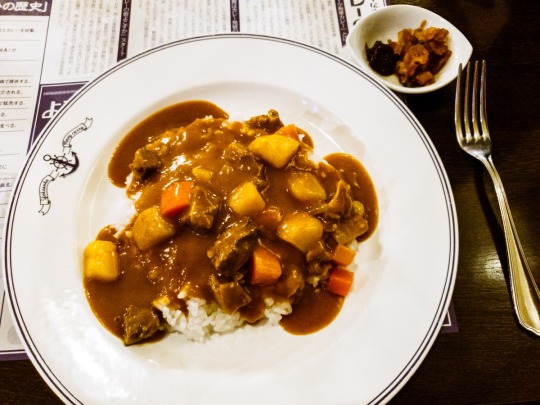
View On WordPress
#Battleship Mikasa#Japanese Curry#Japanese food#Japanese food history#Japanese Maritime Self Defense Force#Japanese Navy#Mikasa Park#Things to do in Kanagawa#things to do in Yokosuka#Things to see in Kanagawa#things to see in Yokosuka#Togo Heihachiro#Two Second Street#Yokosuka Kaigun Curry#Yokosuka Navy Curry#Yokosuka Navy Honpo
0 notes
Text
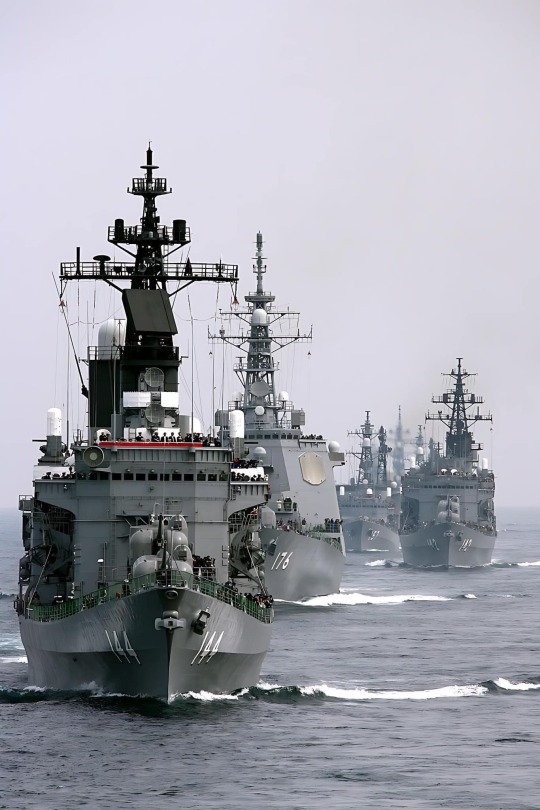
Japanese Maritime Self Defense Force Ships (JMSDF).
69 notes
·
View notes
Text
The Owl House Headcanon on Character's Favorite Japanese Dishes.
Luz Noceda: Okonomiyaki (Hiroshima-Style preferred). She likes it for it is a perfect comforting fusion between pancakes and takoyaki (which she had some bad memory from getting her tongue scrouged by it). Plus, she can choose a variety of fillings, which is great for her neurodivergent vibe (while also easily getting bored).
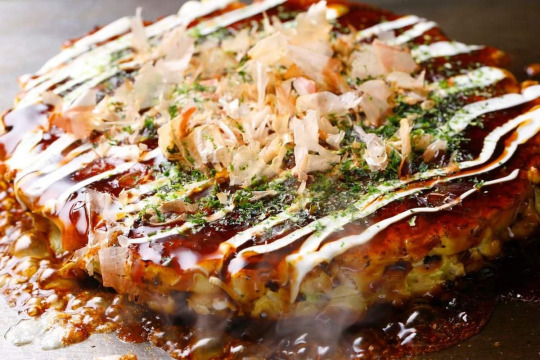
Amity Blight: Zaru Soba. She'd likely go for a dish that is simple yet defines Japanese elements. She would enjoy it with chunky chopped spring onion, wasabi-infused dipping, and hot tea on a side. After a few years of trying more Japanese dishes, she also got into shio udon and yakisoba. (and yakisoba-based okonomiyaki with her sweetheart)
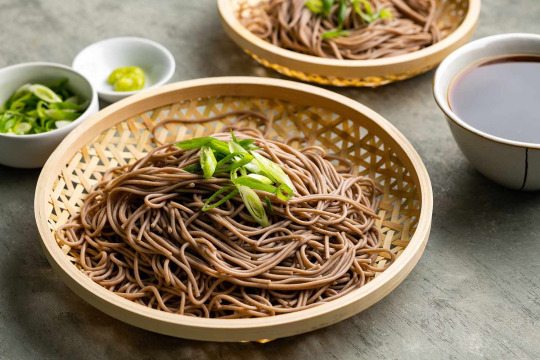
Willow Park: Kimchi Nabe; full of vegetables, proteins from meat, eggs, mushrooms, tofu, and gochujang-rich kimchi (Giving spiciness and Korean-ness that Willow never realized she needed). She loves her nabe with varieties and large quantities of proteins. Especially chicken-based meatballs (like in sumo wrestler Chanko Nabe), chicken breasts, lean slices of beef, and white tofu. Plus, extra spicy.
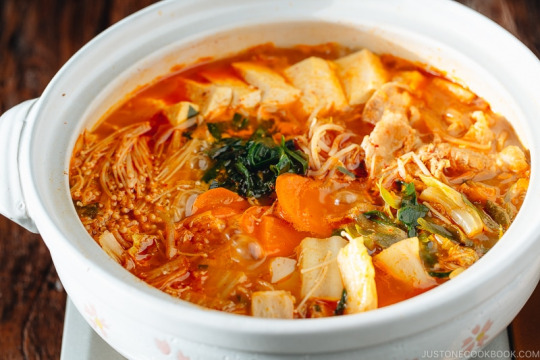
Gus Porter: Omurice with ketchup fried rice underneath a blanket of thin and creamy omelet. He prefers creamy demiglace sauce with mushroom and beef stock base, alongside ketchup and a dash of Kewpie mayo. Maybe steamed bacon with low-sodium, crabstick, or fish sausage for the side protein. Plus, he loves Sanrio and doesn't care about locals' eyes upon him enjoying his two plates of My Melody Omurice.(It's kids' size, so two is it).

Hunter Noceda/Park/Daemonne: Kushiyaki, especially those from old-school Yatai stalls. However, he would avoid poultry-based ones (especially the wings, as tributes to his lifesaver, Flapjack) and alcoholic drinks. He usually goes with beef and vegetables on the same stick. His favorite side drink is Ramune or Calpis yogurt drink. He usually has a few pods of salted edamame first, if offered.

Vee Noceda: Shojin Ryori meal from local Zen Buddhist temples. Somehow, she can tastes 'magic' in food, and enjoy talking about spiritual and morality topics with Buddhist monks(and nuns). She usually not paying them by money but doing them some cleaning and arranging the sutra. She sometimes enjoy draining magic from Omamori (Green one is a yum!).

Edalyn Clawthrone: Tantanmen, extra broth, extra noodles, and a few extra pieces of boiled eggs. With rice on the side. After an extreme night (either work, or a party), she carves for carbs, proteins, and spices. Eventually, it becomes her usual comfort dish. Plus, it was worth her two meals and a pretty budget. If she feels extra fancy, maybe some extra meat as well.

Lilith Clawthrone: Kure's JMSDF (Japan Maritime Self-Defense Force)-style Curry Rice, with milk (low-fat, or soya milk) and salad with a light dressing. She prefers a vegetarian version and original taste that serves Japanese maritime forces. She eventually made her own thanks to befriending a friend who was a chef on a Japanese battleship in the Cold War.

King Clawthrone: Set of different sushi varieties. He is into nigiri and maki with a few simple ingredients. He is into a grilled saltwater eel, salted boiled ebi (or tempura-fried), churnchy cucumber, and tamago. Onigiri is also his go-to, but he is not into raw meat.
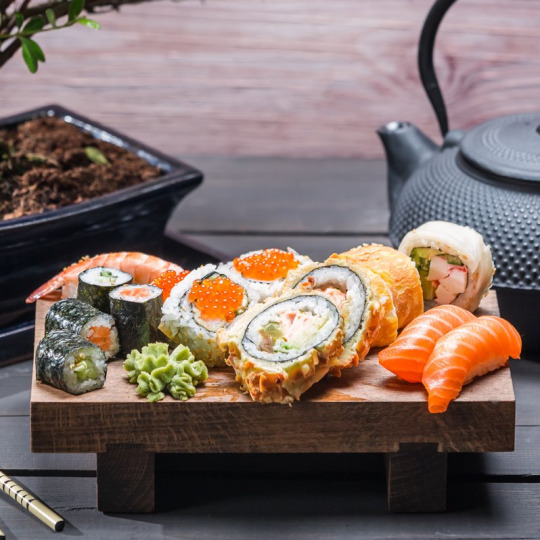
#the owl house#toh headcanon#luz noceda#amity blight#willow park#gus porter#toh hunter#vee toh#headcanon favorite food#japanese food#eda clawthorne#king clawthorne#king toh
29 notes
·
View notes
Text

Japan starts sea tests of its second modified helipter carrier for F-35B jets
Fernando Valduga By Fernando Valduga 12/28/2023 - 22:22 in Military
The Japan Maritime Self-Defense Force (JMSDF) began sea testing for its JS Kaga (DDH 184) helipter carrier after undergoing significant modifications to accommodate F-35B fighters, as announced by JMSDF on December 25.
New images shared on the social media platform X (formerly Twitter), by the service's Escort Flotilla Four depict JS Kaga leaving his pier at the Japan Marine United (JMU) shipyard in the city of Kure, Hiroshima province, to undergo tests at sea.
The Escort Flotilla Four post expressed enthusiasm, stating: "Today's post is about JS Kaga during the sea tests. There is only a little time left until the special modification of JS Kaga is completed! We can't wait!"

The port of origin of JS Kaga is the JMSDF Naval Base of Kure, where the Fleet Four Escort Division is stationed. Although the official date of the sea tests was not disclosed by the JMSDF, an officer confirmed to Naval News that the initial sea tests took place on November 13.
JS Kaga left the JMU shipyard pier in Kure on April 20, marking its first departure in more than a year, after undergoing modifications that transformed its appearance into that of a light aircraft carrier. Notable changes ?? included the modification of the bow section of its cockpit from a trapezoid to a square shape, similar to those of the Wasp class and America-class amphibious assault ships of the U.S. Navy.
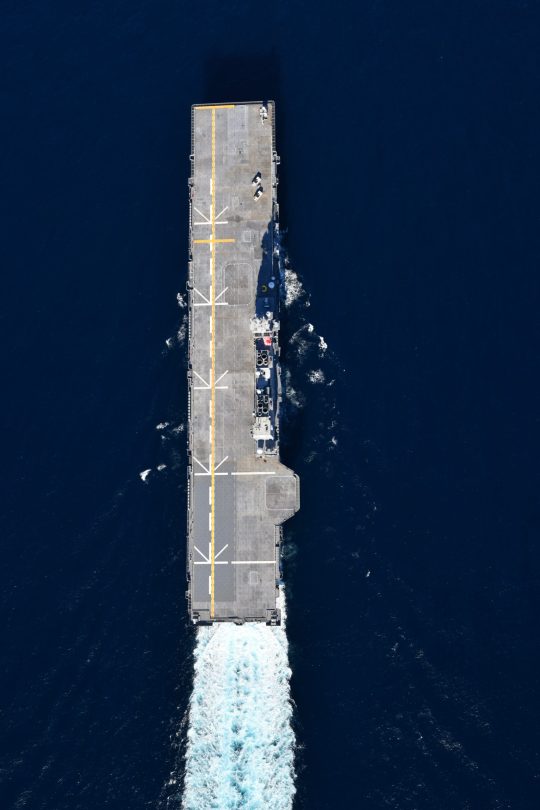
JMSDF plans to complete the modification of its two Izumo-class helipter carriers, JS Izumo and JS Kaga, into aircraft carriers capable of supporting the operations of Lockheed Martin F-35B fighters until fiscal year 2027.
For JS Kaga, the renovation work at JMU's Kure shipyard began in March 2022, involving initial modifications, such as cockpit reinforcement, installation of additional guidance lights, marking of yellow lines in the control cabin for F-35B launches and landings, and incorporating heat-resistant systems at points on the deck for vertical landings. Fiscal year 2023 will see the acquisition of Raytheon's Joint Precision Approach and Landing System (JPALS) and additional modifications to the satellite communication system.

Subsequent and final modifications during the next revision of the Kaga, scheduled to begin at the end of fiscal year 2026, will include changes to the ship's interior compartments.

F-35B during testing on JS Izumo.
Meanwhile, Izumo is expected to undergo modifications to the bow section of its cockpit, transforming it from trapezoid to square during the next fiscal year of 2024, starting in April. The JMSDF allocated $287.3 million for the modifications of the bow section of Izumo in fiscal year 2024 and an additional $4.2 million for the installation of a landing navigation system, which is expected to be Raytheon's JPALS. The Izumo class ships, measuring 248 meters in length and moving 26,000 tons at full load, are the largest Japanese military ships built since World War II, with the capacity to carry up to 14 helicopters.
Tags: Military AviationJMSDF - Japan Maritime Self Defence Force/Japan Maritime Self-Defense Force - Japanese Navyaircraft carrier
Sharing
tweet
Fernando Valduga
Fernando Valduga
Aviation photographer and pilot since 1992, he has participated in several events and air operations, such as Cruzex, AirVenture, Dayton Airshow and FIDAE. He has works published in specialized aviation magazines in Brazil and abroad. He uses Canon equipment during his photographic work in the world of aviation.
Related news
MILITARY
New jet coach for the Russian Air Force
28/12/2023 - 17:00
MILITARY
Elt Group and Leonardo collaborate in the update of the C-27J Spartan electronic warfare set
28/12/2023 - 16:00
HELICOPTERS
Korea Aerospace Industries guarantees contract for second batch of LAH helicopters
28/12/2023 - 14:00
MILITARY
Turkey's ANKA-3 combat drone performs inaugural flight
28/12/2023 - 13:00
INCIDENTS
Indian MiG-29K hunting tire bursts while taxiing
28/12/2023 - 09:00
MILITARY
South Korea signs contract to purchase 20 additional F-35A fighters
28/12/2023 - 08:27
11 notes
·
View notes
Text
As the three countries boost their military ties, one question Yoon is facing is whether South Korea could be implicated in a potential conflict between China and Taiwan. On Monday, Yoon gave a briefing where, without naming a country, he said the three leaders had agreed to "support the maritime security of countries in the Indo-Pacific region to ensure freedom of navigation and trade."
Critics of Yoon are now saying that the agreement worsens national security by raising the risk that Seoul could get pulled into a war over Taiwan, while also jeopardizing ties with China, South Korea's largest trading partner.
The left-wing Kyunghyang newspaper wrote an editorial decrying the agreement, saying that it could pull South Korea into matters in which it is otherwise uninvolved. "In the event of a conflict or crisis in America's broad area of influence in the Indo-Pacific region, there is a high possibility of the U.S. demanding a joint response under the trilateral agreement with South Korea and Japan," the editorial said.
To implement this agreement, the role of the Korean military would have to be expanded in the mid- to long-term from its current focus on countering the [DPRK] to responding to various threats in the Indo-Pacific region. To enable not only “consultation” about these threats but also joint action down the road, the three countries also agreed to “hold annual, named, multi-domain trilateral exercises on a regular basis.”
Two changes are expected in the short term. First, Japan would have more input in the event of a war on the Korean Peninsula. Japan’s role in such a scenario would be to provide rear support (including logistics support) for US reinforcements dispatched to defend the Korean Peninsula under Japan’s Act on Measures to Ensure the Peace and Security of Japan in Perilous Situations in Areas Surrounding Japan of 1999 (renamed the Law Concerning Measures to Ensure Peace and Security of Japan in Situations that Will Have an Important Influence on Japan's Peace and Security in 2016). In that eventuality, any military communication between South Korea and the US would have had to go through the US.
But the consultation to which the three countries have now agreed makes it possible for Japan to directly make various demands of Korea. Japan could ask Korea to allow the Japan Self-Defense Forces (JSDF) to enter Korean territory to rescue Japanese citizens. It could also remain in close communication while using its enemy base strike capability (also called “counterstrike capability”) to launch direct attacks on North Korea.
Furthermore, the US and Japan could ask Korea to allow rear support units in the JSDF to operate in Korean sovereign territory, rather than only in open waters in the East Sea (known to Japan as the Sea of Japan), to enable smoother missions. [...]
While the US is not treaty-bound to defend Taiwan, US President Joe Biden has said on four separate occasions since his inauguration in January 2021 that he would defend against an invasion by mainland China. That’s because allowing China to overrun Taiwan unmolested would spell the end of American hegemony in the Western Pacific, a hegemony the US has maintained since the end of World War II, more than seven decades ago.
There’s also a growing sense inside Japan that a war against Taiwan should be regarded as a war against Japan and that the JSDF should respond aggressively. The late Shinzo Abe, former prime minister of Japan, said as much in several interviews with the press. And current Japanese Prime Minister Fumio Kishida raised eyebrows when he said in the House of Representatives in April that if the US asked Japan to deploy the JSDF to defend Taiwan, Japan would “make a decision based on the specific and individual [situation] in accordance with the Constitution, international law and domestic law.”
Various war simulations run by leading American think tanks have concluded that the US-Japan alliance would be able to prevent a Chinese invasion of Taiwan, if barely, on the assumption that both the US and Japan were fully committed to the war. Given these considerations, Japan has revised three documents related to national security last December and decided to increase its defense budget to 2% of gross domestic product within five years.
If a war were to break out in Taiwan under these grim circumstances, it goes without saying that the US and Japan would use the consultation framework to request a “measured response” from Korea. Along with announcing the redeployment of US Forces Korea, the US could pressure Korea to join Japan in making a direct “military contribution” to peace and stability in the Indo-Pacific region.
While Korea would not be obligated under treaty to comply with any such requests, its refusal would surely cause serious harm to its alliance relationship with the US.
Japanese newspaper the Asahi Shimbun reported Monday that Korean government officials are whispering about this amounting to Korea “crossing the Rubicon” in its relationship with China.
22 Aug 23
17 notes
·
View notes
Text
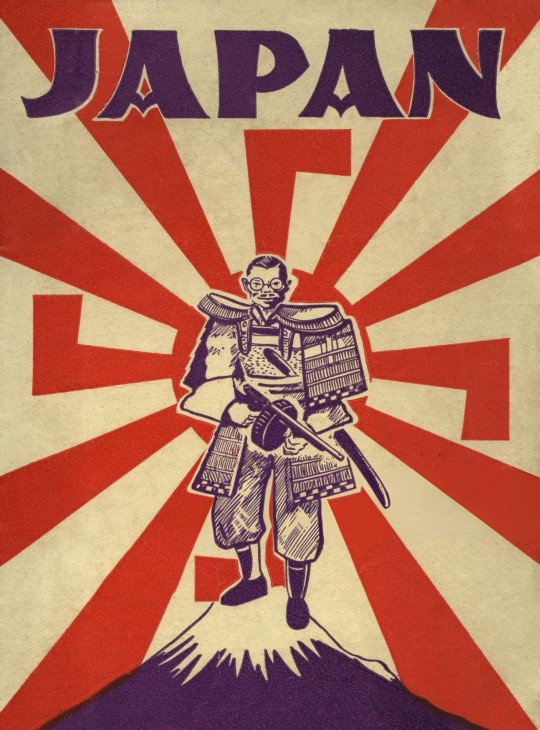
@staff
The Japanese military is known as the Japan Self-Defense Forces (JSDF) and consists of three services: the Ground Self-Defense Force, the Maritime Self-Defense Force, and the Air Self-Defense Force.
3 notes
·
View notes
Text





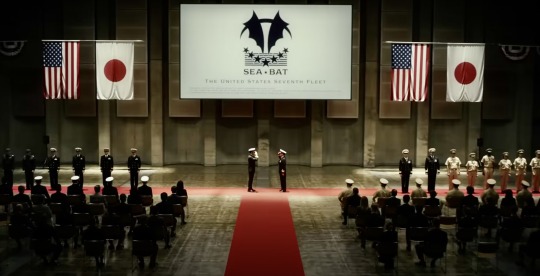

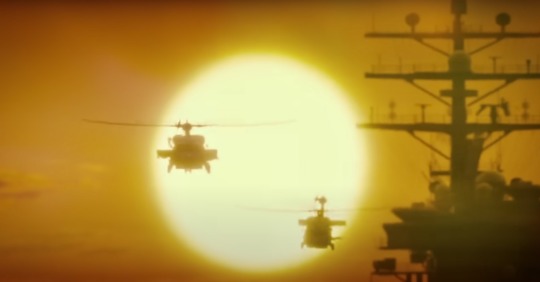

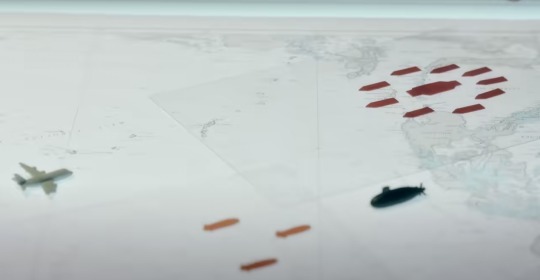

The Silent Service (2023)
Japan's first nuclear submarine built in collaboration with the United States goes missing under the command of Captain Shiro Kaeida (Takao Osawa). Since the submarine is technically under the command of the United States, the country has ordered the destruction of the submarine, viewing it as a threat.
Japan Maritime Self-Defense Force deploy a submarine under the command of Captain Hirosh Fukamachi (Hiroshi Tamaki) to bring back the nuclear submarine safely before the US Navy finds it and destroys it. The story makes audience think about true peace amidst the complexities of international relations.
youtube
It's like a Japanese version of The Hunt for the Red October starring the late Sean Connery where a Soviet Nuclear Submarine intends to defect to the United States as both the US and Soviet Navy race against time to get their hands on the sub before the other.
This Japanese movie is based on the manga of the same name which ran from 1988 to 1996 during the end of the Cold War. I'm looking forward to this as I've always been a fan of military films and political thrillers like Tom Clancy.
The casts for this movie is incredible. They're all my favourite drama actors, like Takao Osawa (Kingdom), Hiroshi Tamaki (The Way of the Househusband), Aya Ueto (Yoshitsune), Tomoya Nakamura (Kamen Rider Black Sun), Yosuke Eguchi (Rurouni Kenshin), and more.
#the silent service#Chinmoku no Kantai#japanese movie#j movie#jmovie#japanese drama#takao osawa#osawa takao#hiroshi tamaki#tamaki hiroshi#aya ueto#ueto aya#tomoya nakamura#nakamura tomoya#yosuke eguchi#eguchi yosuke#asami mizukawa#mizukawa asami#Youtube
7 notes
·
View notes
Photo
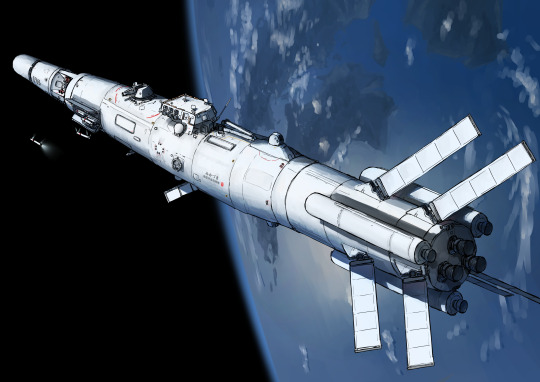
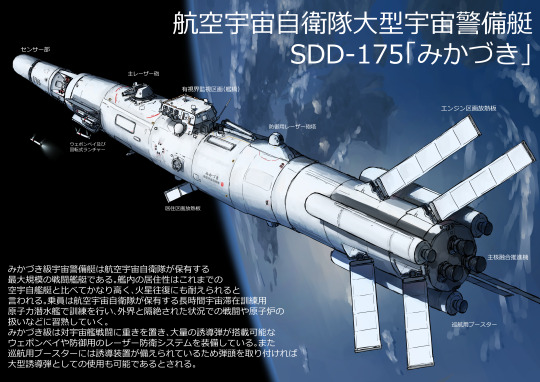
航空宇宙自衛隊大型宇宙警備艇「みかづき」
The Futsutsuki is of the same type. The name "FUTSUZUKI" was chosen as a "security boat" because it is not a combat ship, although the name "destroyer" is used to refer to the Maritime Self-Defense Force (MASDF). Internationally, it is called Space Destroyer. The Maritime Self-Defense Force has yet to deploy its own nuclear-powered submarines, and is not on the best of terms with the Air Self-Defense Force.
The visual surveillance compartment has become a standard feature of the Aerospace Self-Defense Force's space ships, based on its operational experience with the Yuyake-class missile ship (see illust/96150383 ). It is not a combat bridge, but a place for the crew to look out, relax, and check the status of targets in the field of view. Some of the living quarters are located here because the bridge, which extends outward by rotating the ship (the common name, not the official name), can generate a stronger and more stable artificial gravity than the inside of the ship. Some Indian and British ships are also equipped with such "bridges," but they are not common because they are structurally weak points, and at the same time, they reduce propulsion efficiency by shifting the center of gravity. It is a mystery why the Japanese insist so much on installing a bridge on their spacecraft.
On a different note, Space Battleship Yamato is still cool.
20 notes
·
View notes
Text

Case File Tokyo 1954: The Beginning of the Age of Monsters
"I can hardly believe what has just happened. Now it seems Tokyo has no defense."
~ Steve Martin, International Correspondent, United World News.
13 August, 1954. 19:05 PM JST
Japan would be faced with an incident that would lead to one of the most destructive attacks on Japanese soil, and the start of the Age of Monsters. That incident would be the disappearance of the fishing vessel Eiko-Maru. Hours later, a rescue vessel, Bingo-Maru, would suffer the same fate.
Japan Maritime Safety's investigation would eventually lead them to Odo Island that resided near the location of these incidents, and shortly after, the discovery of Monster 01.
Monster 01, or Godzilla as the locals of Odo Island call him, would be targeted by Japanese Naval Forces via depth charges in hopes of ridding him before it could cause any further damage. Unfortunately, this would only lure the beast to Tokyo Bay. Godzilla would first make landfall at Shinagawa, trampling all in his path, shrugging off artillery and canon fire, causing a deadly train wreck, and destroying the Yatsuyama Bridge before returning to the sea.
In the following days, Japan Self Defense Forces would erect a barb-wire fence that would be powered with 50,000 volts of electricity, in hopes of electrocuting Godzilla to death.
At 19:30 JST, 20 August, 1954, Godzilla would make landfall again at Shibaura. With baited breath, Defense Forces would train their turrets upon the beast as he walked closer and closer to the electrical wires. The great beast would bellow in pain as the electricity coursed through it's body. Explosion after explosion would sound as each shot hit their mark. But it would all be for naught as the beast's fins would glow an eerie pale blueish white, and from his maw, beam of light would burst forth, melting the the steel towers in an instant. Nothing could stop Godzilla's wrath.
In the following moments, Shibaura, Shinagawa, Minato, Chiba, and Ginza Wards would be transformed into a sea of flame. Godzilla would then continue his warpath North, beyond the metropolis and along the Tohoku Rail Line.
The JSDF would eventually formulate a plan to save Sendai from the same fate by utilizing jet-fighters and flares to lure Godzilla back out to sea as the city would undergo a total blackout order. This strategy is still in use today and has thankfully had more success than failures.
But no one would ever forget what happened to Tokyo. The ramifications of this disaster would be felt for years to come. Godzilla would still be at large. Japan would be gripped with fear and panic. And this would only be the first of many monsters to appear in the PacRim nations and territories.
______________________________________________________________
If you made it down this far, you may have noticed that events begin to alter towards the end. Well, I did say that the Age of Monsters was supposed to be an original timeline that would borrow events from the films, albeit altered, for certain time frames. This is one of them. There currently isn't an Oxygen Destroyer and there is currently only one Godzilla in this project.
Credits:
CasualGoji - www.deviantart.com/violismodel…
Yamato Style Explosions - bowlroll.net/user/668840
Electrical Towers - bowlroll.net/user/189
Skydome - www.deviantart.com/mrwhitefolk…
Effects:
Autoluminous, ExcellentShadow, Diffusion, SelfThunder
5 notes
·
View notes
Text

NATO Naval Forces conduct exercise with Japanese Maritime Self-Defense Force and Allies http://dlvr.it/TC6Q8z
0 notes
Text
Japanese warship entered China's waters near Taiwan despite warnings, domestic media reports
Ship JS SUZUTSUKI DD-117, an Asagiri-class destroyer in the Japan Maritime Self-Defense Force (MSDF), as it arrives at Tanjung Priok port in Jakarta, Indonesia on Tuesday, September 18, 2018.
Nurphoto | Nurphoto | Getty Images
A Japanese maritime self-defense force destroyer entered Chinese territorial waters recently in spite of warnings by Chinese vessels, Kyodo News reported Thursday.
The…
0 notes
Text

Japanese destroyer, also known as a "kaijo jieitai" or Maritime Self-Defense Force (JMSDF) destroyer
12 notes
·
View notes
Text
Japanese Warship Strays Into China's Territorial Sea During Military Exercise
A Japanese navy warship entered China's territorial sea near Taiwan last week while monitoring a Chinese military live-fire exercise, Japanese media reported on Thursday.

The Japan Maritime Self-Defense Force's 6,800-ton destroyer, Suzutsuki, sailed into Chinese waters on July 4, off the coast of Zhejiang province, according to unnamed diplomatic sources cited by Japanese media. The Suzutsuki is equipped with air defense and anti-ship missiles, a naval main gun, torpedoes, and anti-submarine rockets, designed to counter enemy ships, aircraft, and submarines.
Incident Details
Zhejiang province, located east of the contested East China Sea and north of Taiwan, was the scene of the incident. The area is also near the disputed Senkaku Islands, known as the Diaoyu Islands in China, which are claimed by Beijing but controlled by Japan. China frequently deploys military aircraft and ships around Taiwan, which it views as a breakaway province.
Japanese media reported that the Suzutsuki was tasked with observing Chinese military drills. The maritime authority in Zhejiang had declared a navigational warning and a danger zone for military exercises in the waters off the province from July 3-5.
When the Japanese warship approached within 12 nautical miles of Zhejiang's coast, Chinese forces warned it to leave. Instead, the Suzutsuki increased speed and entered Chinese territorial waters, a rare and provocative move. The warship remained in Chinese waters for about 20 minutes before exiting.
Diplomatic Fallout
China expressed serious concern to Japan over the incident, prompting the Japanese Defense Ministry to launch an investigation into the actions of the Suzutsuki's captain. During a regular press conference on Thursday, Chinese Foreign Ministry spokesperson Lin Jian confirmed that Beijing had protested to Tokyo, labeling the Japanese warship's actions as "illegal and improper." Japan explained the incident as a "technical error," Lin said.
Japanese sources suggested the incident might have been a procedural error, while China's Kyodo News indicated that Beijing suspected a deliberate provocation by Japan.
In Tokyo, Japan's Chief Cabinet Secretary Yoshimasa Hayashi declined to provide details on the incident, refraining from commenting on Japanese military operations.
Legal Context
According to the 1982 United Nations Convention on the Law of the Sea, all ships have the right to transit the territorial waters of another state without undermining the security of the coastal state. The Japanese government insisted that the Suzutsuki was exercising the right of innocent passage in Chinese territorial waters.
However, China argued that the Japanese warship did not comply with its domestic law, which requires foreign vessels to obtain permission before entering territorial waters.
International Implications
The United States, Japan's security treaty ally, has similarly sent warships into waters around China, including the South China Sea, exercising the right of innocent passage without prior notification or permission from Beijing. The Chinese military has accused the U.S. of seriously violating China's sovereignty and security, leading to the expulsion of American warships from its territorial sea.
The incident with the Suzutsuki adds to the ongoing tensions in the region, highlighting the complex dynamics between China, Japan, and their allies. As investigations continue, both nations remain on alert, with diplomatic efforts underway to address and de-escalate the situation.
#Japan#China#Taiwan#TerritorialWaters#Military#Suzutsuki#DiplomaticTensions#EastChinaSea#SenkakuIslands#MaritimeSecurity
0 notes
Text

A Japanese Maritime Self-Defense Force OP-3C Aeries II electronic intelligence aircraft from Maritime Surveillance Squadron 81 flying with a US Navy EA-18G Growler electronic attack aircraft
credit Mandy Lee
@CcibChris via X
5 notes
·
View notes